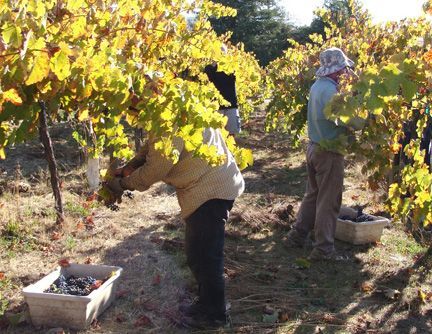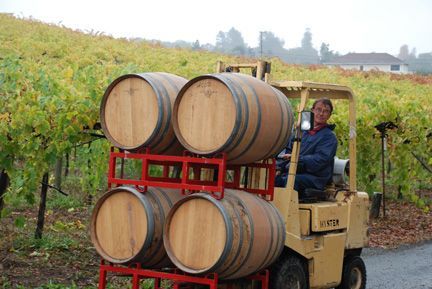HISTORY, TRADITION, and FUTURE
Family-Farmed, Field-Blended Wines
An acorn is a popular symbol of prosperity, good fortune, and potential. Everyone knows mighty oaks from little acorns grow.
ACORN winery started when Bill and Betsy Nachbaur bought Alegría Vineyards in the Russian River Valley. Bill traded in his law books for books on viticulture, pruning shears, and a tractor. In the early years, he was in the vineyards every day, with Betsy helping on weekends. Within a few years she joined Bill full time.
Bill and Betsy started off selling all their grapes to other wineries who produced highly prized Alegría Vineyard-designated wines. Then in 1994, they began making their own wine, establishing ACORN Winery with its first release in 1996, the 1994 Sangiovese. It is fitting that one of the first wines to be released under the "new" ACORN is an Alegría Vineyard Sangiovese.
In 2024 the Nachbaurs joyfully sold the ACORN brand to Melissa Moholt-Siebert, the founder and owner of Ancient Oak Cellars. The long-time friendship and shared values between the two winery-owning families provided a natural and exciting opportunity for both.
Historically, every ACORN wine was made from grapes grown at Alegría. With Melissa's ownership, other family-farmed, field-blend vineyards are being added. Each wine is still a field blend, following the ancient tradition represented in the mixed planting of the original 135-year old Alegría vineyard. Every wine is made by co-fermenting multiple varieties. The wines are blended from the day they are picked. This is what sets ACORN wines apart.
After 35 years, Bill and Betsy still find alegría living in the middle of their vineyards, enjoying the cool Russian River Valley climate. They will continue to farm the vineyard that was their first love, selling grapes to Melissa for ACORN, as well as a number of other award-winning wineries.
Alegría Vineyard History
The original Russian River Valley vineyard that became the Alegría vineyard dates back to 1890. People describe old vineyards like this as “Italian field blends”, but many of them pre-date the Italians, and they seldom include any Italian varieties.
The orginal Alegría vineyard was planted by a family named Brumfield that came from Virginia in 1857. In vineyard censuses done in the 1880s, the Brumfields reported they were growing Zinfandel and Mission. When Bill and Betsy bought the vineyard, there were still a couple of Mission vines near the old house, which is no longer part of our property. Of course, “Zinfandel” meant Zinfandel plus other complementary varieties. The Sangiovese in the Alegría vineyard was added 60 years ago, in 1950, by A. Raffanelli, who owned the vineyard at that time.
The Alegría Vineyard Heritage Vines Zinfandel blocks are a mixed planting that is 78% Zinfandel, 10% Petite Sirah, & 10% Alicante Bouschet. The remaining 2% includes Carignane, Trousseau, Sangiovese, Petit Bouschet, Negrette, Syrah, Plavic Mali, Tannat, Muscat Noir, Peloursin, Beclan, Mataro, Cinsaut, Grenache, and a few white grapes: Palomino and Monbadon. Bill and Betsy believe that the mix of inter-planted varieties evolved over the years. As a vine died and was replaced, it wasn’t necessarily replaced with the same varietal.
The different varieties are inter-planted, and each block in the vineyard has a different mix. We pick all the varieties in a block together and co-ferment them, so they are blended from the day they are picked. After Bill and Betsy bought the property in 1990, they identified and inventoried the existing vines (using ampelography), and then planted the adjacent pasture land to grapes.
Planting a mixture of vines/varietals was standard practice in the 19th century. Also, a certain amount of the mixing might have happened by mistake. When Alicante Bouschet was first released (mid 1870s) it was so popular and in such short supply that you could only buy it mixed with Petit Bouschet.
Alegría Vineyards is registerd by the Historic Vineyard Society. For futher details on this historic vineyard, please visit the Alegría Vineyard page on The Historic Vineyard Society website.
CONNECT WITH ACORN

CONNECT WITH
BILL & BETSY
P.O. Box 2061
Healdsburg, CA 95448
(707) 433-6440
nachbaur@alegriavineyards.com







